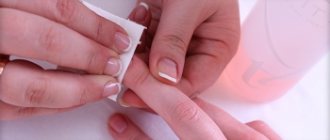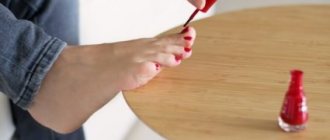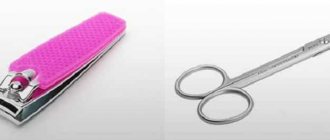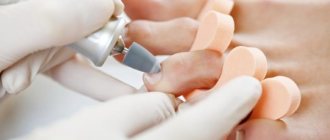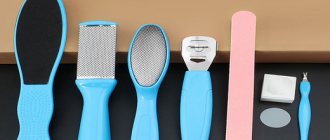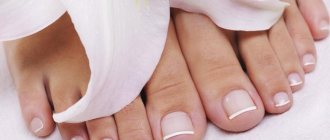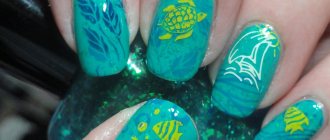The podiatrist knows what tools are needed for a pedicure. He deals with foot problems and treats all foot diseases. His arsenal includes special medical instruments for performing nail removal surgery, prosthetics, and an apparatus for medical pedicure. For a normal hygiene procedure, the list of tools will be small. In addition, some medical devices may be required - curettes, tweezers and others.
There are two ways to perform a pedicure: hardware and edged. But even purchasing a special device does not save you from solving all problems. The best option would be to purchase tools for a combined pedicure for your pedicure room, which combines both techniques. This should be considered in detail.
Trim method
Tools for pedicures performed using the classic trimming method have remained virtually unchanged for thousands of years. They perform cutting, abrasive and auxiliary functions during the procedure. There are a large number of their types, but they can all be divided into three groups.
Cutting instruments have a blade (or two), with which the master removes keratinized areas of the skin, shortens the length of nails, cuts out calluses and keratinization, and removes cuticles. These are the following items:
- Pedicure nail clippers. They have straight blades and can handle the toughest nail plates.
- Knipser - miniature tweezers. It has a beautiful cut shape, works on the guillotine principle and preserves the structure of the nail as much as possible when cutting.
- Pedicure knife. Now it is not a medieval frightening instrument, but quite harmless. It resembles a safety razor: it is also designed to use removable blades. May be completely metal, but may also have plastic parts.
- Removable blades. They are special, suitable only for a pedicure knife. They have a standard size and can be used with any brand of tool.
- Abrasive devices are various pedicure graters of various shapes. The amount of abrasive per square centimeter is measured in grits. To work, you need at least two files: 180 and 240 grit. They are usually produced double-sided, which is very convenient.
Tools that have auxiliary functions are orange sticks, curettes, pushers/scrapers and a universal foot block that can be used to file nails and polish heels. This is a block coated with abrasive. It can have edges of different grit or the same.
Pedicure tools
Pedicure instruments can be classified depending on their area of application:
- For working with nails,
- For the cuticle,
- For foot skin care,
- Therapeutic (fighting calluses, corns, fungus, ingrown toenails, etc.)
Let's look at them in order, starting with what you need to care for your nails and cuticles.
- Scissors . They are also different from manicure ones. To trim toenails, you need scissors with straight ends, since here the corners of the nails are not rounded - this can lead to ingrown nails. Curved scissors can be used to trim cuticles.
- Wire cutters . They are used to remove the cuticle after softening. You can also use them to get rid of hangnails, although they are very rare on your feet. Do not use nail clippers to trim your nails, otherwise they will quickly become dull, and frequent sharpening of the clippers is a very expensive procedure!
- Tweezers . This tool is convenient for cutting nails if they are very neglected and dense: tweezers have a higher degree of compression than scissors, and can easily cope where scissors require enormous effort.
- Files . They can be divided into subtypes depending on the purpose of use: To correct the length of toenails, you need a coarser (coarse-grained with slight abrasiveness) and thinner file than for hands, since the nails themselves are thicker and denser, and it is difficult to approach them more difficult. Therefore, I recommend using a glass file: it is not as bulky as Teflon or plastic ones, and does not lead to splitting of nails like metal ones. In general, the length of the nails is not completely cut off: it is cut off with scissors or nippers, and then the end is sealed with a file, moving from the edges to the center (pay attention to the direction, because on our hands we move the file in one direction).
- To polish the nail plate (for example, when preparing to apply gel polish), you need a special grinder file or buffer.
- to polish (give shine) to natural nails.
To care for the skin of the feet use:
- Scraper (machine) . This is a modern alternative to the well-known pumice stone, and is used for the same purpose - to cut off rough areas of skin.
- Pumice stone or foot grater. The disadvantage of pumice when treating the soles of the feet, calluses and cracks is that it quickly becomes clogged. But a modern alternative - glass or metal graters with micro knives located at a certain angle, do their job perfectly and remain in good condition.
Unedged method
Due to the spread of various diseases transmitted through pedicure tools, another method of treating feet has begun to gain popularity. The unedged method involves performing the procedure without the use of cutting tools. This type of pedicure is done in SPA centers, paying great attention to the use of special creams and scrubs based on fruit beta-hydroxy acids. They soften and loosen skin cells, allowing you to remove all excess with the help of files and graters.
To shorten nails, use files with an abrasiveness of 120/180 grit. Using the rough side will quickly remove excess length, and correct their shape with the 180 grit side.
Graters are used starting from 80 grit. Gradually replacing them with smaller ones, they reach 240 grit. There are also pedicure polishers that allow you to achieve a silky skin surface after the procedure.
If your feet are very neglected, have cracked heels, calluses and corns, this type of pedicure will not be able to solve all problems. Some operations will have to be performed in hardware. However, regular use of pedicure floats can keep your feet in good condition.
When carrying out a procedure, disposable instruments are often needed that can be used to perform various operations. These include orange sticks, toothpicks, cotton buds and finger separators. There are disposable abrasive attachments for hardware cutters. They are disposed of after each client.
Varieties
Professional care for ladies' feet involves not only performing a pedicure, but also caring for the heels and skin of the feet. All products used by specialists for a comprehensive professional pedicure are divided into several groups.
- Cleansing cosmetics.
This group includes numerous scrubs, peelings, etc. In most cases, they are used before massaging the legs, improving blood circulation in the area of the feet, and also to remove dead skin cells of the epidermis.
- Keratolics.
This category of products is often used in combination with other hardware pedicure products to soften the skin, cuticles, and remove calluses. Available in the form of foams, gels, creams, etc. They can be a very effective alternative to standard baths.
- Crema.
Creams, gels, lotions are used to moisturize the skin of the legs after cosmetic procedures.
All decorative cosmetics are divided into groups depending on their action and effect:
- softening;
- moisturizing;
- antifungal and antimicrobial;
- deodorizing;
- tonic.
In addition to the above tools for professional pedicure, there are a large number of tools. To achieve the desired effect, you need to choose exactly what will make your legs look well-groomed and beautiful.
Hardware method
Performing a pedicure using the trimmed method is contraindicated for some diseases. One of them is diabetes mellitus. In this case, the feet are processed only with a milling cutter. The use of various attachments helps to carefully drill out the usual dry calluses, corns, polish the plantar area and remove cuticles.
There are many of them. Each master selects nozzles for himself. The main thing is to purchase them in stores that sell professional pedicure tools. The minimum set includes the following cutters:
- Cylindrical, which reduces the length of nails.
- A diamond nozzle in the form of a truncated cone, which is used to process the edge and end of the nail.
- Cylindrical with notches for removing excess volume in case of hyperkeratosis.
- Ball-shaped diamond nozzle for processing cuticles.
- Needle-shaped carbide for processing nail folds.
- Rubber nozzles with replaceable abrasive caps.
- Carbide titanium attachment for working with the plantar part of the foot.
A professional device may be supplied with a set of cutters supplied by the manufacturer. They have a standard size suitable for all devices.
What tools are needed for a hardware pedicure?
The procedure for hardware care of toenails requires special equipment, which includes a whole list of devices. Below we provide a description of these pedicure tools:
Pedicure machine
This miracle of technology looks like an electric machine. As a rule, the device has different rotation speeds, as well as several types of cutters. If you want your work to be comfortable and of high quality, choose a device with a built-in vacuum cleaner from the online store of professional pedicure tools. This feature will avoid a lot of dust from your skin and nails.
The pedicure device allows you to clean your feet by polishing. This is especially important when treating thin skin, such as cuticles or the side folds of the nail plates. In this case, thin nozzles are used.
Feet and heels are treated using nozzles with large diameters. They easily cope with rough skin.
Machine
Used to cleanse rough skin on the feet. It consists of a handle and sharpened special blades, a grinding file for heels. The latter removes all roughness after using the machine.
Attention! If you do a pedicure at home, it is better not to use the machine too often. Otherwise, you can achieve the opposite result, since renewed skin is very sensitive, its damage can lead to even greater roughening of the skin of the feet.
Roller saw
Using this device, you can treat your heels or feet completely. Using a roller file, you will not damage the skin, since the stratum corneum of the skin is removed very thinly and gradually. The effect of using an electric saw is superior to what we get from regular pumice.
Read material on the topic: Files for grinding feet
Combined method
It will not be possible to completely perform a pedicure using only one method in difficult cases where there are ingrown toenails, cracked heels and other problems. Therefore, a universal set of pedicure tools will include both types of tools in order to use a combined technology if necessary. In addition to the standard set, the following items are purchased:
- Ball-shaped burs for drilling calluses of different diameters.
- Metal file for ingrown toenails.
- Curettes, left and right.
- Nippers for ingrown toenails.
Professional pedicure tools of this specific nature can only be purchased in specialized stores.
How to choose the right one
When choosing a set of pedicure tools, you should pay attention to the following qualities:
- Convenience. The tool should fit comfortably in your hand, and there should not be any problems during operation.
- Sharpening quality. Experts advise choosing hand-sharpened pedicure accessories. Nippers, nail scissors, tweezers and files with manufacturing defects can injure the skin and nails.
- Blade quality. A good tool should immediately cut the cuticle, and not tear it. The latter contributes to the development of the inflammatory process. The blade of the dead skin removal machine should not block the view. Otherwise, they refuse to purchase the instrument. Sharp blades have increased cross-country ability. They move smoothly over the skin without clinging to minor protrusions.
- Material. Choose scissors, nippers and tongs made of stainless steel, which must be durable. Blades made from soft materials become dull quickly.
- Dimensions. The length of the blades of the nippers should be 5-10 mm. This size is considered the most convenient when working with cuticles. The type of pliers depends on the type of nails. To trim thick nails, use a large tool, and thin nails, use a small one.
Manicure items you may need
Often, special care is required when treating toes. This happens, for example, when preparing nails for applying gel polish. To file nails and give them a beautiful shape, use 180/240 grit manicure files. After filing the nails with the rougher side, the file is turned over and the end of the nail is sealed with the 240 grit side. With the same side you can remove detachments from the nail. Pterygium - the lower layer of the cuticle - can be removed by pushers (from the English “push” - push) and scrapers (manicure hatchets).
When the trimming method is used, manicure tweezers are used. It is convenient to choose a blade length of 5 mm. Some people remove the cuticle with nail scissors. They are available for skin, with thin blades, and for trimming nails, with wider blades. Experts do not recommend shortening your nails with scissors - the keratin layers become wrinkled and the nails begin to peel.
These are universal tools for manicure and pedicure, which can be sold in specialized departments. When purchasing them, they are guided by the choice of a brand from a well-known manufacturer of quality products.
Complete list of required tools
In order to provide complete foot care, all nuances are taken into account. You will need to purchase the following tools for manicure and pedicure:
- Nail clipper.
- Pedicure nippers.
- Manicure tweezers for skin.
- Files for ingrown toenails.
- Pedicure knife and a set of blades for it.
- Pedicure graters with grit from 80 to 240 units.
- Nippers for ingrown toenails.
- Curettes, left and right.
- Disposable instruments.
- Pedicure and manicure apparatus with a set of cutters.
- Pusher/scraper
- Manicure files 180/240 grit.
There are various devices for performing certain operations. For example, a ceramic hoof has recently appeared, which is convenient for cleaning the pterygium before applying gel polish. But there are also unprofessional pedicure tools that are rejected by specialists. One of them is a “fork” for cutting the cuticle. It is difficult to completely remove excess skin with this item because it removes chips of the same thickness. But when processing cuticles and nail folds, it is necessary to constantly monitor the depth of the cut. Therefore, when using a “fork,” blood vessels are often hit.
What tools are needed for home pedicure and manicure?
It is necessary to purchase a set of tools for manicure and pedicure to care for nail plates and feet at home. But making a complete list of what you might need is not easy. First of all, this list depends on what exactly you are going to do.
If you plan to perform only a classic manicure without decorative nail design, you will need a few tools. If you want to use nail design, special devices will make this process easier and more technologically advanced.
There are situations when it is profitable and convenient to buy a whole set of pedicure tools. It is sold in a special case, which is convenient to take with you when traveling. But it is worth noting that it includes only basic devices - for treating nails, and for caring for the skin on the heels or for decorating the nail plates you will have to buy additionally.
A home kit must include the following list of tools:
- scissors with straight ends;
- sticks and cuticle nippers;
- medium-sized tweezers;
- set of nail files.
Read material on the topic: Professional pedicure files: 3 main selection criteria
Tools for pedicure at home
To care for your feet at home, you don’t have to buy an expensive device. There are household appliances that allow you to effortlessly remove dry skin from your heels. They are completely safe; when you press them a little harder during operation, the rotation of the cutter stops. These devices are specially made to have low power. Usually, with their regular use, there are no large corns.
To treat fingers, you can use the attachments included in the package. For household devices, the diameter of the cutter does not allow the use of professional caps. Therefore, it is better to purchase a tool for home pedicure, for which you can later buy consumables. Typically, such devices do not last long, because over time the cutters become dull, and it is no longer possible to perform the procedure well.
The most economical option would be the trimming method, which gives good results if done weekly.
List of pedicure tools for home:
- Nail clippers or nail clippers.
- Pedicure grater 180/240.
- Pusher/scraper.
- Skin tweezers or nail scissors.
- Pedicure block.
If a problem such as an ingrown toenail bothers you quite often, you can purchase a special metal file. This is a tool with a narrow, serrated edge. They are convenient for reducing the side part of the nail that grows into the skin.
Advice from professionals
Some pedicure tools require a training course. This is due to the fact that a layperson has little experience in removing excess skin. He may not understand the location of the main vessels and capillaries, finds it difficult to determine the thickness of the skin in different places of the foot, distinguish the color of living and exfoliated tissue, and does not know many other features.
Experts warn against removing corns yourself using a pedicure knife. They work in conditions of good lighting and full visibility. When doing a pedicure yourself, these requirements are difficult to fulfill, so it is very easy to inflict a wound on yourself that will take a long time to heal.
Nail clippers are not intended for cutting nails. They can become unbalanced and become unusable. Thin blades are easily deformed, and then all that remains is to throw away the tool. They should not be dropped on the floor as the blades may become bent or stop closing tightly. The same applies to manicure scissors.
Pedicurists work only with sharp instruments. How do you know when it’s time to sharpen your tweezers or scraper? When the working blades become dull, the work progresses slowly, burrs remain on the proximal (posterior) nail fold after cutting the cuticle, and the scraper injures the skin due to the fact that it has to be pressed harder. In this case, they should be sent to a sharpening workshop.
Which pedicure tools to choose
To prevent shopping trips from becoming a tradition, you should not skimp on quality. At first glance, the metal may seem good. But when working in damp conditions it begins to rust. To prevent this from happening, you should choose stainless steel instruments made from medical steel. These will be reliable, high-quality products that will last a long time. They are usually hand sharpened.
When choosing a tool, it is important to try how the handles of the tweezers move, to see if they are too tight. You should also choose the curve of the handles that best suits your palm. If a woman with a small hand has to work with large handles, her palm will quickly cramp due to muscle strain.
You should buy everything from a professional pedicure equipment store, giving preference to German brands. Companies such as Singer and Solinger are widely known for their excellent quality. They value their reputation and produce reliable tools. When choosing a pedicure device, it is better to choose an inexpensive original device than a replica of a well-known brand. Its power can be 25 - 35 Watts, the rotation speed of the cutter can be from 25,000 rpm. You should check whether its parts can be replaced and whether they can be purchased freely. The diameter of the cutter should be standard.

